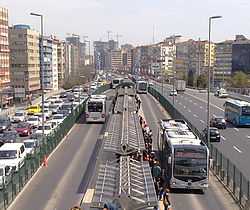Bus rapid transit creep
| “ | Some American systems reviewed had so few essential characteristics that calling them a BRT system at all does a disservice to efforts to gain broader adoption of BRT in the United States.[1]:7 | ” |
BRT creep comprises several types of gradual erosions in service that sometimes affect a bus rapid transit (BRT) system, resulting in a service that is not up to the standards promised by BRT advocates. Sometimes described as a "surface subway", BRT aims to combine the capacity and speed of a light rail or metro system with the flexibility, cost and simplicity of a bus system. BRT creep occurs when a system that promises these features instead acts more like a standard, non-rapid bus system.
Description
The most extreme versions of BRT creep lead to systems that cannot even truly be recognized as "Bus Rapid Transit". For example, a rating from the Institute for Transportation and Development Policy determined that the Boston Silver Line was best classified as "Not BRT" after local decision makers gradually decided to do away with most BRT-specific features.[1]:45 The study also evaluates a New York City "BRT" line as "Not BRT".[1]:47
Worried about similar circumstances, Virginia writer Kevin Beekman urges residents in areas planned for BRT development to use the ITDP scoring worksheet (BRT Standard) as an assessment tool.[2] Another Washington-area writer, Dan Reed, furthers this sentiment, writing that if BRT creep is allowed to reach its full conclusion, it's "bad for commuters, but it's also bad for taxpayers who were sold a high-end service only to find out that we just painted the buses a different color".[3]
According to Dan Malouff, a transit planner who was one of the earliest people to use the phrase, the slippery slope towards BRT creep varies widely from system to system. He says in a piece republished by the Washington Post that "there are a thousand corners like that you can cut that individually may or may not hurt too much, but collectively add up to the difference between BRT and a regular bus". Major compromises in service are highlighted by one or more common symptoms:[4]
- The bus runs in shared HOV lanes rather than true dedicated lanes
- True "stations" instead become "stops"
- Pre-pay is done away with, slowing passenger boarding
- The bus does not receive priority at traffic lights
Counterarguments, remediation, and alternative labels
Author and activist Matthew Yglesias has argued in Slate Magazine that BRT creep is a very real worry, but that the issue is not "a problem with buses, it's a problem with cheapskates".[5]
Houston Tomorrow points out some ways local legislation can prevent BRT creep: "The new section on Bus Rapid Transit specifically defines it as having a separated right-of-way (at least for the majority of the line and during peak periods), defined stations, short headways and signal priority."[6]
At least one political candidate has also referred to BRT creep using the less widely used term "bus creep".
See also
- BRT Standard
- Bus rapid transit
- Guided busway
References
- ↑ 1.0 1.1 1.2 Weinstock, Annie, et al. "Recapturing Global Leadership in Bus Rapid Transit: A Survey of Select U.S. Cities". Institute for Transportation and Development Policy. Retrieved 2014-05-23.
- ↑ Alexandria BRT
- ↑ Reed, Dan. "To build support for MoCo BRT, start with the basics". Retrieved 6 March 2013.
- ↑ Malouff, Dan (3 September 2011). "The problem of BRT creep". The Washington Post. Retrieved 6 March 2013.
- ↑ Yglesias, Matthew (7 August 2013). "Menace of BRT creep". Slate. Retrieved 1 May 2014.
- ↑ Dietrichson, Matt (7 July 2012). "How will the new transpo bill affect transit policy?". Retrieved 1 May 2014.
